Auditing and Assurance Services: Assertion Risks and Key Audit Matters
VerifiedAdded on 2023/04/23
|14
|3721
|363
Report
AI Summary
This report delves into the realm of auditing and assurance services, focusing on the critical analysis of audit assertions within provided case studies. It examines assertions such as cut off, accuracy, and valuation related to inventory, and accuracy regarding property, plant, and equipment. The report identifies potential risks associated with these assertions and explores how auditors can address them. It references ASA 701 to outline the objectives and requirements for auditors in determining key audit matters and communicating them in audit reports. The report further provides rationales for the identified key audit matters and includes a table that discloses these matters, their significance, and the audit procedures used to address them. Overall, the report offers a comprehensive overview of audit assertions, risks, and the process of identifying and addressing key audit matters in the context of financial statement audits.
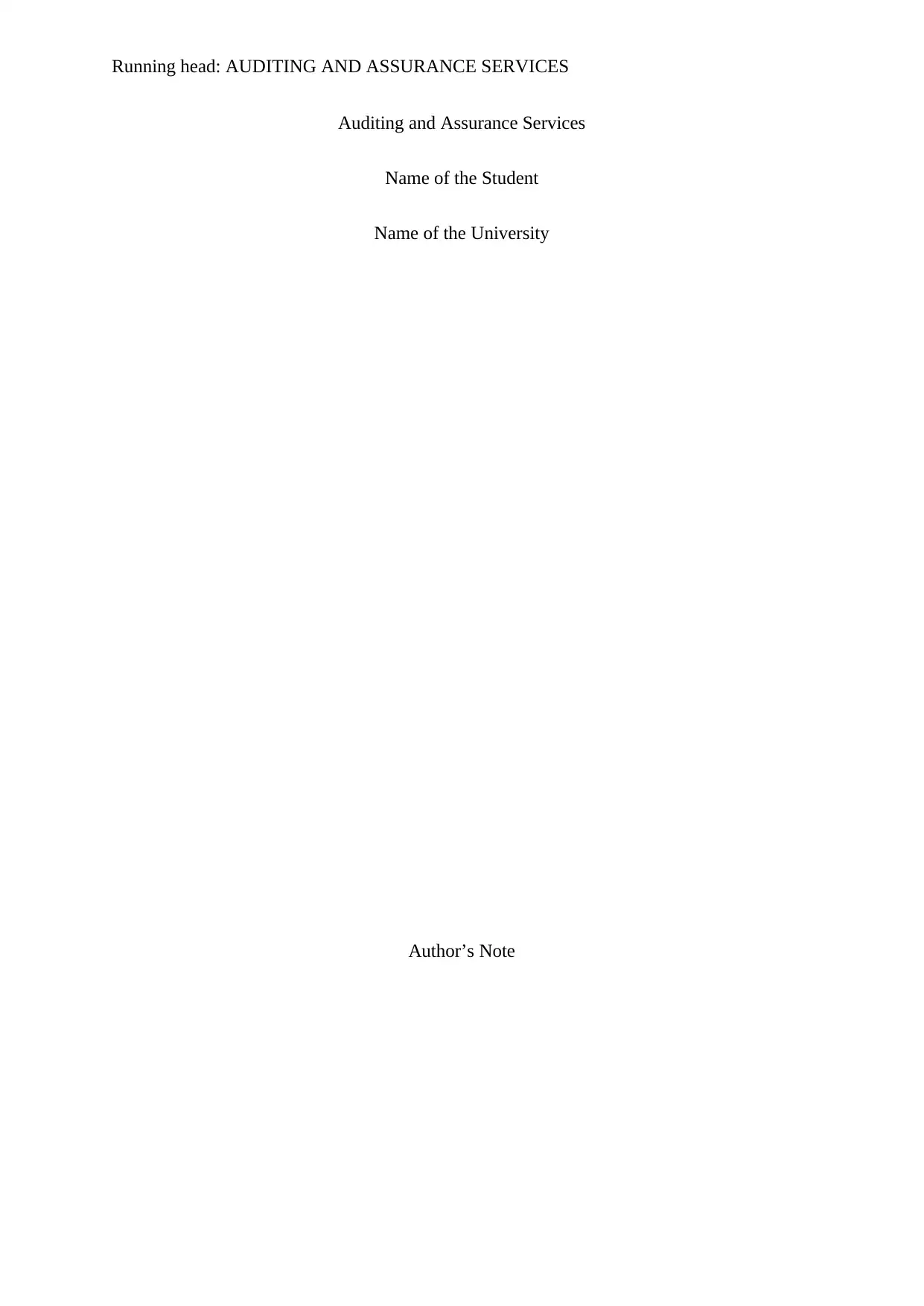
Running head: AUDITING AND ASSURANCE SERVICES
Auditing and Assurance Services
Name of the Student
Name of the University
Author’s Note
Auditing and Assurance Services
Name of the Student
Name of the University
Author’s Note
Paraphrase This Document
Need a fresh take? Get an instant paraphrase of this document with our AI Paraphraser
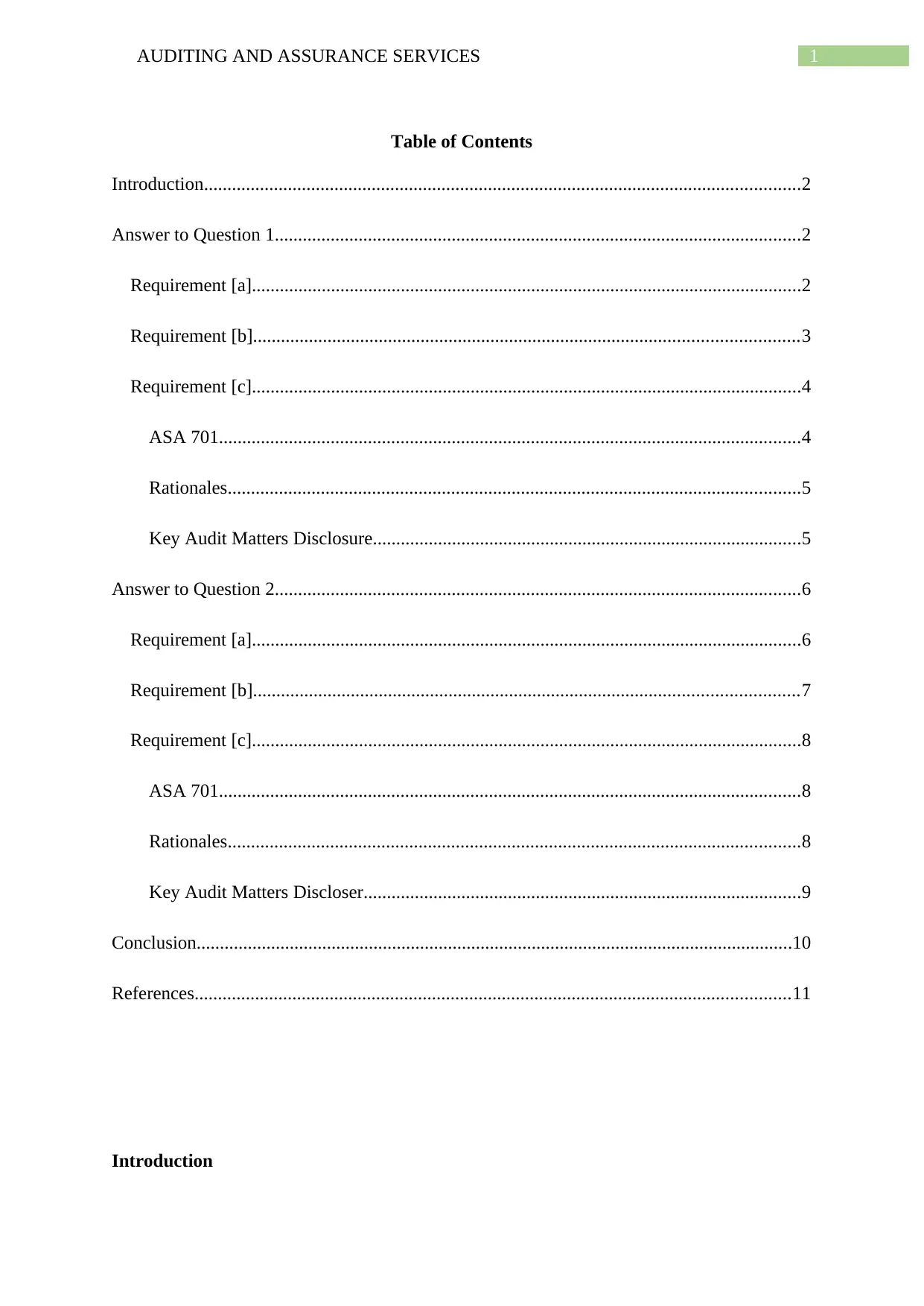
1AUDITING AND ASSURANCE SERVICES
Table of Contents
Introduction................................................................................................................................2
Answer to Question 1.................................................................................................................2
Requirement [a]......................................................................................................................2
Requirement [b].....................................................................................................................3
Requirement [c]......................................................................................................................4
ASA 701.............................................................................................................................4
Rationales...........................................................................................................................5
Key Audit Matters Disclosure............................................................................................5
Answer to Question 2.................................................................................................................6
Requirement [a]......................................................................................................................6
Requirement [b].....................................................................................................................7
Requirement [c]......................................................................................................................8
ASA 701.............................................................................................................................8
Rationales...........................................................................................................................8
Key Audit Matters Discloser..............................................................................................9
Conclusion................................................................................................................................10
References................................................................................................................................11
Introduction
Table of Contents
Introduction................................................................................................................................2
Answer to Question 1.................................................................................................................2
Requirement [a]......................................................................................................................2
Requirement [b].....................................................................................................................3
Requirement [c]......................................................................................................................4
ASA 701.............................................................................................................................4
Rationales...........................................................................................................................5
Key Audit Matters Disclosure............................................................................................5
Answer to Question 2.................................................................................................................6
Requirement [a]......................................................................................................................6
Requirement [b].....................................................................................................................7
Requirement [c]......................................................................................................................8
ASA 701.............................................................................................................................8
Rationales...........................................................................................................................8
Key Audit Matters Discloser..............................................................................................9
Conclusion................................................................................................................................10
References................................................................................................................................11
Introduction
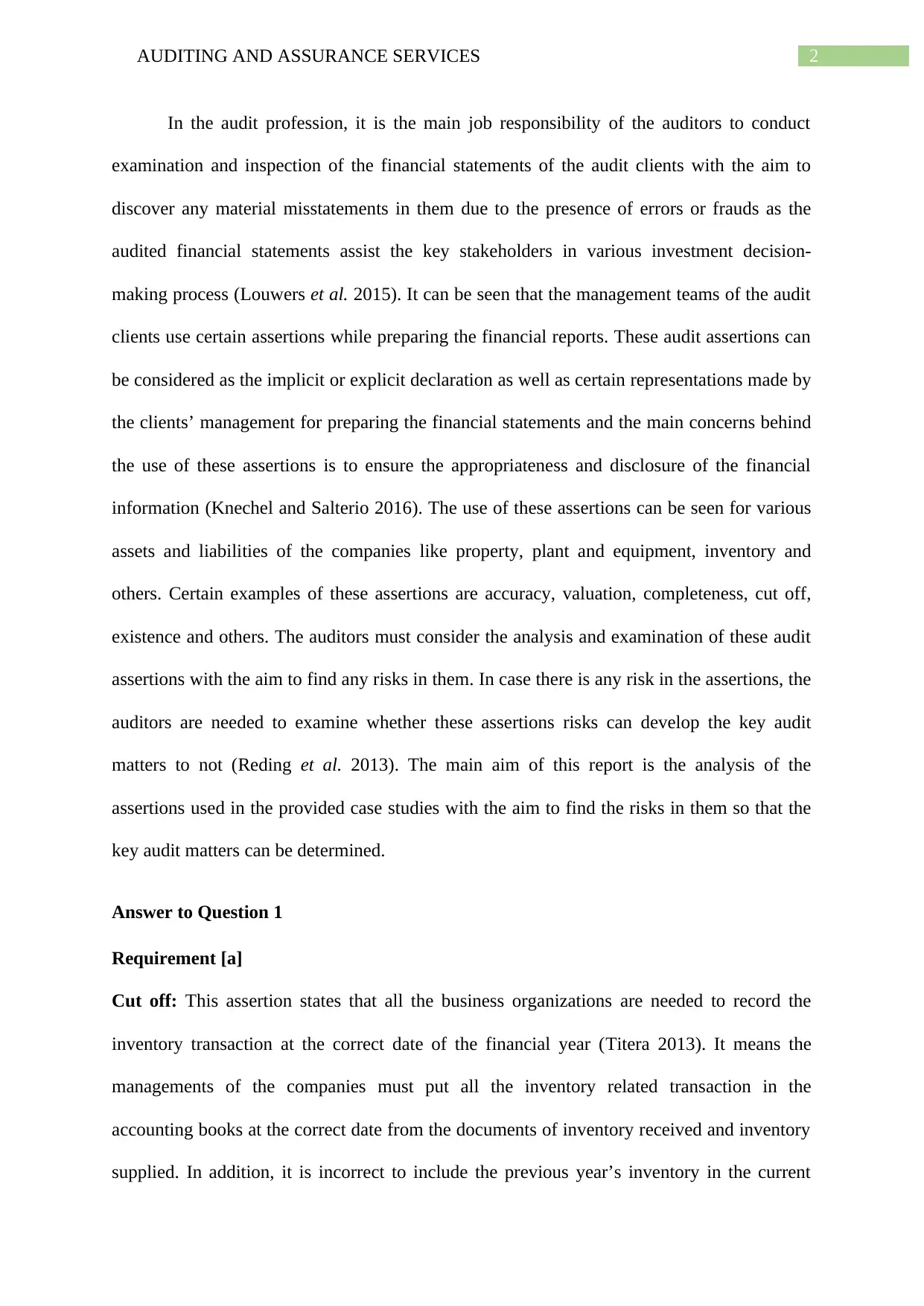
2AUDITING AND ASSURANCE SERVICES
In the audit profession, it is the main job responsibility of the auditors to conduct
examination and inspection of the financial statements of the audit clients with the aim to
discover any material misstatements in them due to the presence of errors or frauds as the
audited financial statements assist the key stakeholders in various investment decision-
making process (Louwers et al. 2015). It can be seen that the management teams of the audit
clients use certain assertions while preparing the financial reports. These audit assertions can
be considered as the implicit or explicit declaration as well as certain representations made by
the clients’ management for preparing the financial statements and the main concerns behind
the use of these assertions is to ensure the appropriateness and disclosure of the financial
information (Knechel and Salterio 2016). The use of these assertions can be seen for various
assets and liabilities of the companies like property, plant and equipment, inventory and
others. Certain examples of these assertions are accuracy, valuation, completeness, cut off,
existence and others. The auditors must consider the analysis and examination of these audit
assertions with the aim to find any risks in them. In case there is any risk in the assertions, the
auditors are needed to examine whether these assertions risks can develop the key audit
matters to not (Reding et al. 2013). The main aim of this report is the analysis of the
assertions used in the provided case studies with the aim to find the risks in them so that the
key audit matters can be determined.
Answer to Question 1
Requirement [a]
Cut off: This assertion states that all the business organizations are needed to record the
inventory transaction at the correct date of the financial year (Titera 2013). It means the
managements of the companies must put all the inventory related transaction in the
accounting books at the correct date from the documents of inventory received and inventory
supplied. In addition, it is incorrect to include the previous year’s inventory in the current
In the audit profession, it is the main job responsibility of the auditors to conduct
examination and inspection of the financial statements of the audit clients with the aim to
discover any material misstatements in them due to the presence of errors or frauds as the
audited financial statements assist the key stakeholders in various investment decision-
making process (Louwers et al. 2015). It can be seen that the management teams of the audit
clients use certain assertions while preparing the financial reports. These audit assertions can
be considered as the implicit or explicit declaration as well as certain representations made by
the clients’ management for preparing the financial statements and the main concerns behind
the use of these assertions is to ensure the appropriateness and disclosure of the financial
information (Knechel and Salterio 2016). The use of these assertions can be seen for various
assets and liabilities of the companies like property, plant and equipment, inventory and
others. Certain examples of these assertions are accuracy, valuation, completeness, cut off,
existence and others. The auditors must consider the analysis and examination of these audit
assertions with the aim to find any risks in them. In case there is any risk in the assertions, the
auditors are needed to examine whether these assertions risks can develop the key audit
matters to not (Reding et al. 2013). The main aim of this report is the analysis of the
assertions used in the provided case studies with the aim to find the risks in them so that the
key audit matters can be determined.
Answer to Question 1
Requirement [a]
Cut off: This assertion states that all the business organizations are needed to record the
inventory transaction at the correct date of the financial year (Titera 2013). It means the
managements of the companies must put all the inventory related transaction in the
accounting books at the correct date from the documents of inventory received and inventory
supplied. In addition, it is incorrect to include the previous year’s inventory in the current
⊘ This is a preview!⊘
Do you want full access?
Subscribe today to unlock all pages.

Trusted by 1+ million students worldwide

3AUDITING AND ASSURANCE SERVICES
year. However, the case of Green Computer Solutions describes that inventory of 2018
includes 26% sales of 2018 and 17% sales of 2017. As per the above discussion, it is the
incorrect recording of inventory in the books of the company that indicate towards the
presence of error in the process of inventory valuation (Hall 2015). Thus, this assertion is at
risk.
Accuracy and Valuation: The presence of this assertion indicates that it is the responsibility
of the companies to conduct the valuation of inventory in the accurate manner. Hence, the
managements of the companies are needed to ensure certain aspects; first, the need to
accurately conduct the physical inventory count; second, they are required to take calculate
the correct amount of costs of goods sold in the income statements by taking the value from
the balance sheet (Bumgarner and Vasarhelyi 2018). It can be seen from the provided
information about Advanced Computer Solutions that the company has recently moved the
inventory from one central warehouse to six different warehouses. Hence, this movement of
the inventory can lead to the error in the inventory counting process. This aspect can affect
the computation of costs of goods sold in the income statements as the company reports the
inventory value in the balance sheet based on the results in the physical inventory count
process (van Buuren et al. 2014). Hence, this assertion can be considered at risk.
Requirement [b]
With the aim to test the cut off assertion of inventory, the auditor is needed to identify
the aspect that whether the company has recorded the inventory related transactions at the
correct date (Groomer and Murthy 2018). For this, verification of the documents of goods
received and good supplied needs to be done by the auditors. After that, the auditor should
review the inventory valuation process for recognising any irrational events that can lead to
slow moving of the inventories. After that, the auditor needs to review whether there was any
year. However, the case of Green Computer Solutions describes that inventory of 2018
includes 26% sales of 2018 and 17% sales of 2017. As per the above discussion, it is the
incorrect recording of inventory in the books of the company that indicate towards the
presence of error in the process of inventory valuation (Hall 2015). Thus, this assertion is at
risk.
Accuracy and Valuation: The presence of this assertion indicates that it is the responsibility
of the companies to conduct the valuation of inventory in the accurate manner. Hence, the
managements of the companies are needed to ensure certain aspects; first, the need to
accurately conduct the physical inventory count; second, they are required to take calculate
the correct amount of costs of goods sold in the income statements by taking the value from
the balance sheet (Bumgarner and Vasarhelyi 2018). It can be seen from the provided
information about Advanced Computer Solutions that the company has recently moved the
inventory from one central warehouse to six different warehouses. Hence, this movement of
the inventory can lead to the error in the inventory counting process. This aspect can affect
the computation of costs of goods sold in the income statements as the company reports the
inventory value in the balance sheet based on the results in the physical inventory count
process (van Buuren et al. 2014). Hence, this assertion can be considered at risk.
Requirement [b]
With the aim to test the cut off assertion of inventory, the auditor is needed to identify
the aspect that whether the company has recorded the inventory related transactions at the
correct date (Groomer and Murthy 2018). For this, verification of the documents of goods
received and good supplied needs to be done by the auditors. After that, the auditor should
review the inventory valuation process for recognising any irrational events that can lead to
slow moving of the inventories. After that, the auditor needs to review whether there was any
Paraphrase This Document
Need a fresh take? Get an instant paraphrase of this document with our AI Paraphraser
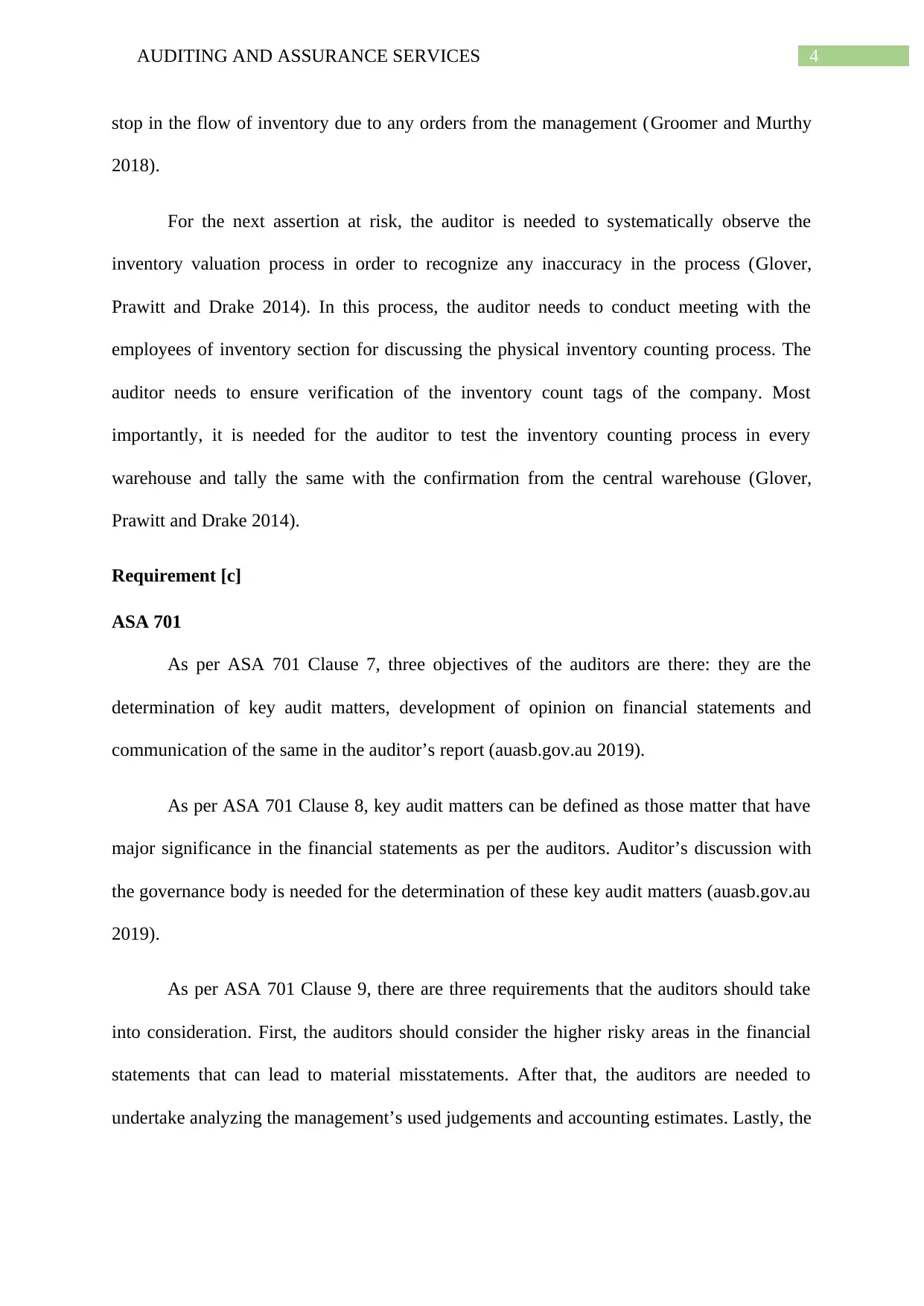
4AUDITING AND ASSURANCE SERVICES
stop in the flow of inventory due to any orders from the management (Groomer and Murthy
2018).
For the next assertion at risk, the auditor is needed to systematically observe the
inventory valuation process in order to recognize any inaccuracy in the process (Glover,
Prawitt and Drake 2014). In this process, the auditor needs to conduct meeting with the
employees of inventory section for discussing the physical inventory counting process. The
auditor needs to ensure verification of the inventory count tags of the company. Most
importantly, it is needed for the auditor to test the inventory counting process in every
warehouse and tally the same with the confirmation from the central warehouse (Glover,
Prawitt and Drake 2014).
Requirement [c]
ASA 701
As per ASA 701 Clause 7, three objectives of the auditors are there: they are the
determination of key audit matters, development of opinion on financial statements and
communication of the same in the auditor’s report (auasb.gov.au 2019).
As per ASA 701 Clause 8, key audit matters can be defined as those matter that have
major significance in the financial statements as per the auditors. Auditor’s discussion with
the governance body is needed for the determination of these key audit matters (auasb.gov.au
2019).
As per ASA 701 Clause 9, there are three requirements that the auditors should take
into consideration. First, the auditors should consider the higher risky areas in the financial
statements that can lead to material misstatements. After that, the auditors are needed to
undertake analyzing the management’s used judgements and accounting estimates. Lastly, the
stop in the flow of inventory due to any orders from the management (Groomer and Murthy
2018).
For the next assertion at risk, the auditor is needed to systematically observe the
inventory valuation process in order to recognize any inaccuracy in the process (Glover,
Prawitt and Drake 2014). In this process, the auditor needs to conduct meeting with the
employees of inventory section for discussing the physical inventory counting process. The
auditor needs to ensure verification of the inventory count tags of the company. Most
importantly, it is needed for the auditor to test the inventory counting process in every
warehouse and tally the same with the confirmation from the central warehouse (Glover,
Prawitt and Drake 2014).
Requirement [c]
ASA 701
As per ASA 701 Clause 7, three objectives of the auditors are there: they are the
determination of key audit matters, development of opinion on financial statements and
communication of the same in the auditor’s report (auasb.gov.au 2019).
As per ASA 701 Clause 8, key audit matters can be defined as those matter that have
major significance in the financial statements as per the auditors. Auditor’s discussion with
the governance body is needed for the determination of these key audit matters (auasb.gov.au
2019).
As per ASA 701 Clause 9, there are three requirements that the auditors should take
into consideration. First, the auditors should consider the higher risky areas in the financial
statements that can lead to material misstatements. After that, the auditors are needed to
undertake analyzing the management’s used judgements and accounting estimates. Lastly, the
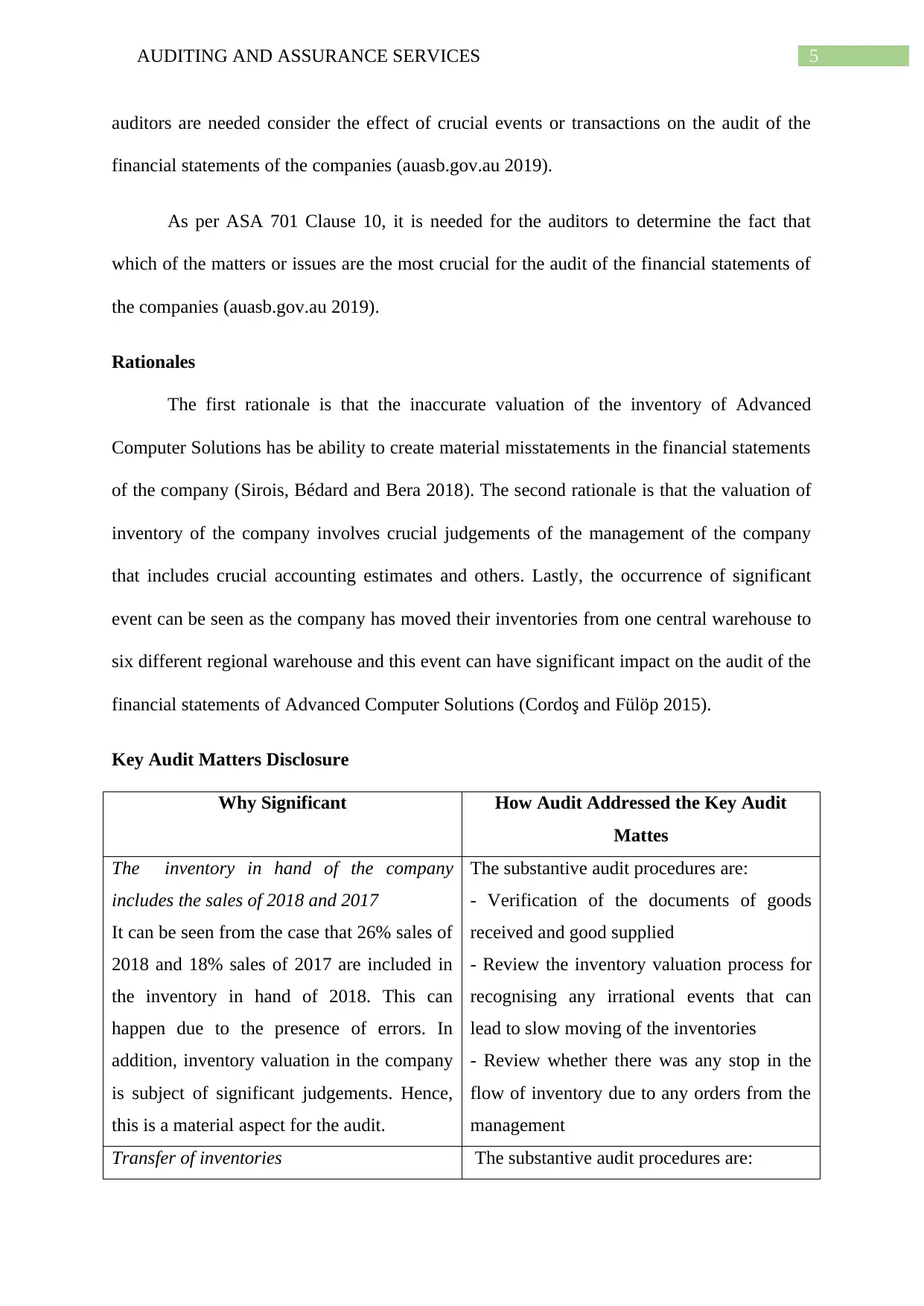
5AUDITING AND ASSURANCE SERVICES
auditors are needed consider the effect of crucial events or transactions on the audit of the
financial statements of the companies (auasb.gov.au 2019).
As per ASA 701 Clause 10, it is needed for the auditors to determine the fact that
which of the matters or issues are the most crucial for the audit of the financial statements of
the companies (auasb.gov.au 2019).
Rationales
The first rationale is that the inaccurate valuation of the inventory of Advanced
Computer Solutions has be ability to create material misstatements in the financial statements
of the company (Sirois, Bédard and Bera 2018). The second rationale is that the valuation of
inventory of the company involves crucial judgements of the management of the company
that includes crucial accounting estimates and others. Lastly, the occurrence of significant
event can be seen as the company has moved their inventories from one central warehouse to
six different regional warehouse and this event can have significant impact on the audit of the
financial statements of Advanced Computer Solutions (Cordoş and Fülöp 2015).
Key Audit Matters Disclosure
Why Significant How Audit Addressed the Key Audit
Mattes
The inventory in hand of the company
includes the sales of 2018 and 2017
It can be seen from the case that 26% sales of
2018 and 18% sales of 2017 are included in
the inventory in hand of 2018. This can
happen due to the presence of errors. In
addition, inventory valuation in the company
is subject of significant judgements. Hence,
this is a material aspect for the audit.
The substantive audit procedures are:
- Verification of the documents of goods
received and good supplied
- Review the inventory valuation process for
recognising any irrational events that can
lead to slow moving of the inventories
- Review whether there was any stop in the
flow of inventory due to any orders from the
management
Transfer of inventories The substantive audit procedures are:
auditors are needed consider the effect of crucial events or transactions on the audit of the
financial statements of the companies (auasb.gov.au 2019).
As per ASA 701 Clause 10, it is needed for the auditors to determine the fact that
which of the matters or issues are the most crucial for the audit of the financial statements of
the companies (auasb.gov.au 2019).
Rationales
The first rationale is that the inaccurate valuation of the inventory of Advanced
Computer Solutions has be ability to create material misstatements in the financial statements
of the company (Sirois, Bédard and Bera 2018). The second rationale is that the valuation of
inventory of the company involves crucial judgements of the management of the company
that includes crucial accounting estimates and others. Lastly, the occurrence of significant
event can be seen as the company has moved their inventories from one central warehouse to
six different regional warehouse and this event can have significant impact on the audit of the
financial statements of Advanced Computer Solutions (Cordoş and Fülöp 2015).
Key Audit Matters Disclosure
Why Significant How Audit Addressed the Key Audit
Mattes
The inventory in hand of the company
includes the sales of 2018 and 2017
It can be seen from the case that 26% sales of
2018 and 18% sales of 2017 are included in
the inventory in hand of 2018. This can
happen due to the presence of errors. In
addition, inventory valuation in the company
is subject of significant judgements. Hence,
this is a material aspect for the audit.
The substantive audit procedures are:
- Verification of the documents of goods
received and good supplied
- Review the inventory valuation process for
recognising any irrational events that can
lead to slow moving of the inventories
- Review whether there was any stop in the
flow of inventory due to any orders from the
management
Transfer of inventories The substantive audit procedures are:
⊘ This is a preview!⊘
Do you want full access?
Subscribe today to unlock all pages.

Trusted by 1+ million students worldwide

6AUDITING AND ASSURANCE SERVICES
It can be seen from the provided case that the
company has transferred their inventories in
six new warehouses from the central one.
This can create error in inventory counting
process. In addition, this process is subject to
judgement and hence, crucial for auditing.
- Systematically observe the inventory
valuation process
- Conduct meeting with the employees of
inventory section for discussing the physical
inventory counting process
- Verification of the inventory count tags of
the company
- Test the inventory counting process in
every warehouse and tally the same with the
confirmation from the central warehouse
Answer to Question 2
Requirement [a]
Valuation: As per this particular assertion, the companies are needed to report the assets,
liabilities and equity in the correct value that is cost value less accumulated depreciation
(Kharisova and Kozlova 2014). For this reason, the need is to consider the appropriate rate of
depreciation for deriving the actual depreciation expenses on the assets. It can be seen from
the case of Green Machine Ltd that appropriate depreciation rates have not been applied on
the property, plant and equipment of the company as low rate of depreciation has been
considered (Appelbaum, Kogan and Vasarhelyi 2017). For the application for incorrect rates
of depreciation, it is not possible to ensure the correct valuation of property, plant and
equipment which can create material effects on the financial statements. For this reason, it
can be said that this assertion is at the risk.
Accuracy: As per this assertion, it is needed for the managements of the companies to
accurately conduct all the transactions related to property, plant and equipment that include
the proper classification of the revenue as well as capital expenses related to these assets
(Byrnes et al. 2018). The case of Green Machine Ltd shows that the company has not treated
It can be seen from the provided case that the
company has transferred their inventories in
six new warehouses from the central one.
This can create error in inventory counting
process. In addition, this process is subject to
judgement and hence, crucial for auditing.
- Systematically observe the inventory
valuation process
- Conduct meeting with the employees of
inventory section for discussing the physical
inventory counting process
- Verification of the inventory count tags of
the company
- Test the inventory counting process in
every warehouse and tally the same with the
confirmation from the central warehouse
Answer to Question 2
Requirement [a]
Valuation: As per this particular assertion, the companies are needed to report the assets,
liabilities and equity in the correct value that is cost value less accumulated depreciation
(Kharisova and Kozlova 2014). For this reason, the need is to consider the appropriate rate of
depreciation for deriving the actual depreciation expenses on the assets. It can be seen from
the case of Green Machine Ltd that appropriate depreciation rates have not been applied on
the property, plant and equipment of the company as low rate of depreciation has been
considered (Appelbaum, Kogan and Vasarhelyi 2017). For the application for incorrect rates
of depreciation, it is not possible to ensure the correct valuation of property, plant and
equipment which can create material effects on the financial statements. For this reason, it
can be said that this assertion is at the risk.
Accuracy: As per this assertion, it is needed for the managements of the companies to
accurately conduct all the transactions related to property, plant and equipment that include
the proper classification of the revenue as well as capital expenses related to these assets
(Byrnes et al. 2018). The case of Green Machine Ltd shows that the company has not treated
Paraphrase This Document
Need a fresh take? Get an instant paraphrase of this document with our AI Paraphraser
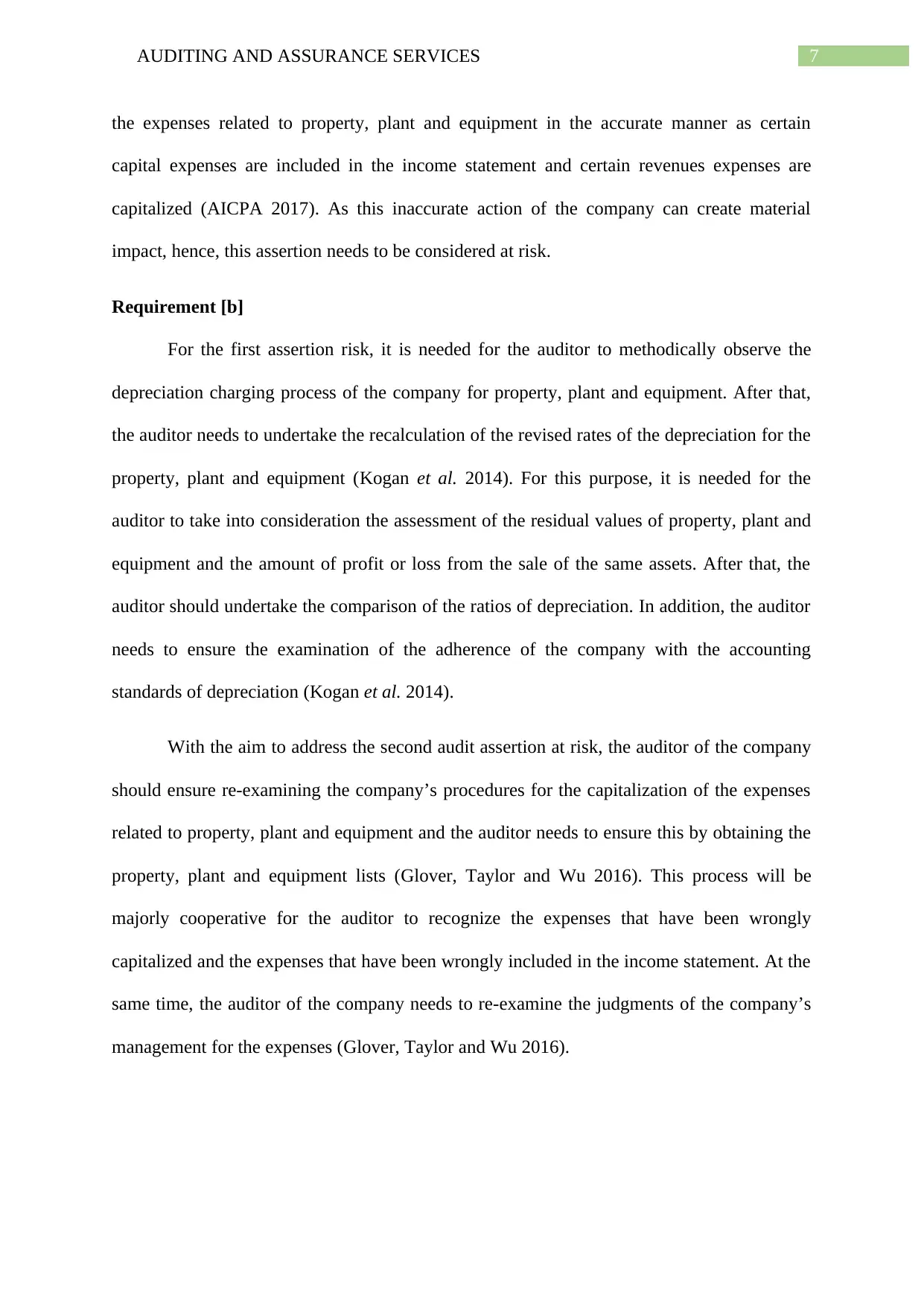
7AUDITING AND ASSURANCE SERVICES
the expenses related to property, plant and equipment in the accurate manner as certain
capital expenses are included in the income statement and certain revenues expenses are
capitalized (AICPA 2017). As this inaccurate action of the company can create material
impact, hence, this assertion needs to be considered at risk.
Requirement [b]
For the first assertion risk, it is needed for the auditor to methodically observe the
depreciation charging process of the company for property, plant and equipment. After that,
the auditor needs to undertake the recalculation of the revised rates of the depreciation for the
property, plant and equipment (Kogan et al. 2014). For this purpose, it is needed for the
auditor to take into consideration the assessment of the residual values of property, plant and
equipment and the amount of profit or loss from the sale of the same assets. After that, the
auditor should undertake the comparison of the ratios of depreciation. In addition, the auditor
needs to ensure the examination of the adherence of the company with the accounting
standards of depreciation (Kogan et al. 2014).
With the aim to address the second audit assertion at risk, the auditor of the company
should ensure re-examining the company’s procedures for the capitalization of the expenses
related to property, plant and equipment and the auditor needs to ensure this by obtaining the
property, plant and equipment lists (Glover, Taylor and Wu 2016). This process will be
majorly cooperative for the auditor to recognize the expenses that have been wrongly
capitalized and the expenses that have been wrongly included in the income statement. At the
same time, the auditor of the company needs to re-examine the judgments of the company’s
management for the expenses (Glover, Taylor and Wu 2016).
the expenses related to property, plant and equipment in the accurate manner as certain
capital expenses are included in the income statement and certain revenues expenses are
capitalized (AICPA 2017). As this inaccurate action of the company can create material
impact, hence, this assertion needs to be considered at risk.
Requirement [b]
For the first assertion risk, it is needed for the auditor to methodically observe the
depreciation charging process of the company for property, plant and equipment. After that,
the auditor needs to undertake the recalculation of the revised rates of the depreciation for the
property, plant and equipment (Kogan et al. 2014). For this purpose, it is needed for the
auditor to take into consideration the assessment of the residual values of property, plant and
equipment and the amount of profit or loss from the sale of the same assets. After that, the
auditor should undertake the comparison of the ratios of depreciation. In addition, the auditor
needs to ensure the examination of the adherence of the company with the accounting
standards of depreciation (Kogan et al. 2014).
With the aim to address the second audit assertion at risk, the auditor of the company
should ensure re-examining the company’s procedures for the capitalization of the expenses
related to property, plant and equipment and the auditor needs to ensure this by obtaining the
property, plant and equipment lists (Glover, Taylor and Wu 2016). This process will be
majorly cooperative for the auditor to recognize the expenses that have been wrongly
capitalized and the expenses that have been wrongly included in the income statement. At the
same time, the auditor of the company needs to re-examine the judgments of the company’s
management for the expenses (Glover, Taylor and Wu 2016).

8AUDITING AND ASSURANCE SERVICES
Requirement [c]
ASA 701
According to ASA 701, Section 7, there are three objectives for the auditors; they are
determination of key audit matters, formulation of opinion on financial statements and
communication of the same in the auditor’s report (auasb.gov.au 2019).
According to ASA 701, Section 8, key audit matters can be defined as those issues
that contain key importance in the financial statements as per the auditors. Auditor’s
discussion with the governance body is compulsory for the determination of these key audit
matters (auasb.gov.au 2019).
According to ASA 701, Section 9, there are three requirements that the auditors
should comply with. First, the auditors need to consider the upper risky areas in the financial
statements that can contribute to material misstatements. After that, the auditors are needed to
commence analyzing the management’s utilized judgements and accounting estimates.
Lastly, the auditors are needed consider the consequence of crucial events or transactions on
the audit of the financial statements of the companies (auasb.gov.au 2019).
According to ASA 701, Section 10, it is obligatory for the auditors to determine the
fact that which of the matters or issues are the most central for the audit of the financial
statements of the companies (auasb.gov.au 2019).
Rationales
It can be said as per the first rationale that the inaccurate application of depreciation
and wrong division of the expenses are capable in creating material impact on the financial
statements of Green Machine Ltd (Christensen, Glover and Wolfe 2014). It needs to be
mentioned as per the second rationale that the management team of the company has used
certain judgements including accounting estimates in the valuation of property, plant and
Requirement [c]
ASA 701
According to ASA 701, Section 7, there are three objectives for the auditors; they are
determination of key audit matters, formulation of opinion on financial statements and
communication of the same in the auditor’s report (auasb.gov.au 2019).
According to ASA 701, Section 8, key audit matters can be defined as those issues
that contain key importance in the financial statements as per the auditors. Auditor’s
discussion with the governance body is compulsory for the determination of these key audit
matters (auasb.gov.au 2019).
According to ASA 701, Section 9, there are three requirements that the auditors
should comply with. First, the auditors need to consider the upper risky areas in the financial
statements that can contribute to material misstatements. After that, the auditors are needed to
commence analyzing the management’s utilized judgements and accounting estimates.
Lastly, the auditors are needed consider the consequence of crucial events or transactions on
the audit of the financial statements of the companies (auasb.gov.au 2019).
According to ASA 701, Section 10, it is obligatory for the auditors to determine the
fact that which of the matters or issues are the most central for the audit of the financial
statements of the companies (auasb.gov.au 2019).
Rationales
It can be said as per the first rationale that the inaccurate application of depreciation
and wrong division of the expenses are capable in creating material impact on the financial
statements of Green Machine Ltd (Christensen, Glover and Wolfe 2014). It needs to be
mentioned as per the second rationale that the management team of the company has used
certain judgements including accounting estimates in the valuation of property, plant and
⊘ This is a preview!⊘
Do you want full access?
Subscribe today to unlock all pages.

Trusted by 1+ million students worldwide
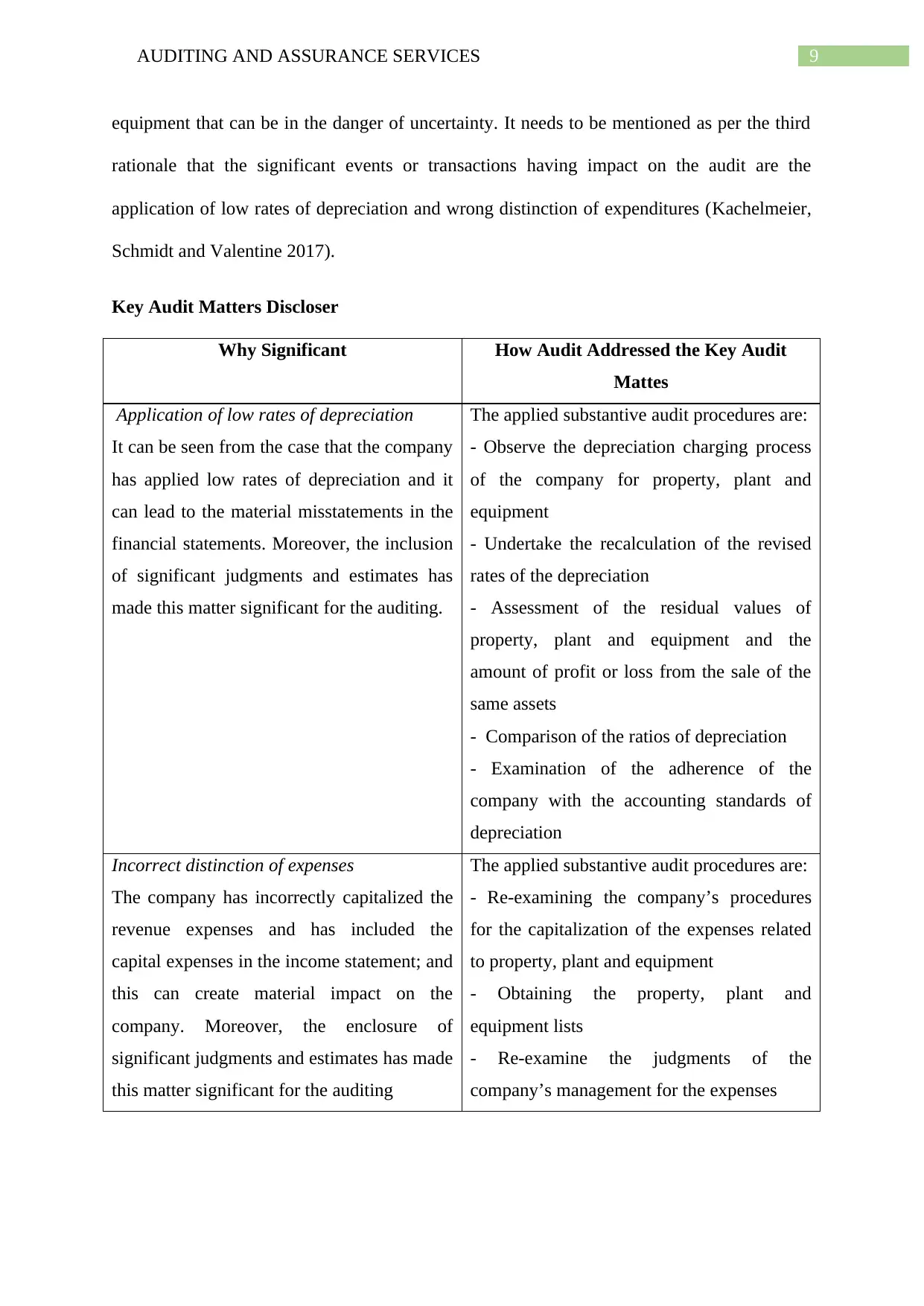
9AUDITING AND ASSURANCE SERVICES
equipment that can be in the danger of uncertainty. It needs to be mentioned as per the third
rationale that the significant events or transactions having impact on the audit are the
application of low rates of depreciation and wrong distinction of expenditures (Kachelmeier,
Schmidt and Valentine 2017).
Key Audit Matters Discloser
Why Significant How Audit Addressed the Key Audit
Mattes
Application of low rates of depreciation
It can be seen from the case that the company
has applied low rates of depreciation and it
can lead to the material misstatements in the
financial statements. Moreover, the inclusion
of significant judgments and estimates has
made this matter significant for the auditing.
The applied substantive audit procedures are:
- Observe the depreciation charging process
of the company for property, plant and
equipment
- Undertake the recalculation of the revised
rates of the depreciation
- Assessment of the residual values of
property, plant and equipment and the
amount of profit or loss from the sale of the
same assets
- Comparison of the ratios of depreciation
- Examination of the adherence of the
company with the accounting standards of
depreciation
Incorrect distinction of expenses
The company has incorrectly capitalized the
revenue expenses and has included the
capital expenses in the income statement; and
this can create material impact on the
company. Moreover, the enclosure of
significant judgments and estimates has made
this matter significant for the auditing
The applied substantive audit procedures are:
- Re-examining the company’s procedures
for the capitalization of the expenses related
to property, plant and equipment
- Obtaining the property, plant and
equipment lists
- Re-examine the judgments of the
company’s management for the expenses
equipment that can be in the danger of uncertainty. It needs to be mentioned as per the third
rationale that the significant events or transactions having impact on the audit are the
application of low rates of depreciation and wrong distinction of expenditures (Kachelmeier,
Schmidt and Valentine 2017).
Key Audit Matters Discloser
Why Significant How Audit Addressed the Key Audit
Mattes
Application of low rates of depreciation
It can be seen from the case that the company
has applied low rates of depreciation and it
can lead to the material misstatements in the
financial statements. Moreover, the inclusion
of significant judgments and estimates has
made this matter significant for the auditing.
The applied substantive audit procedures are:
- Observe the depreciation charging process
of the company for property, plant and
equipment
- Undertake the recalculation of the revised
rates of the depreciation
- Assessment of the residual values of
property, plant and equipment and the
amount of profit or loss from the sale of the
same assets
- Comparison of the ratios of depreciation
- Examination of the adherence of the
company with the accounting standards of
depreciation
Incorrect distinction of expenses
The company has incorrectly capitalized the
revenue expenses and has included the
capital expenses in the income statement; and
this can create material impact on the
company. Moreover, the enclosure of
significant judgments and estimates has made
this matter significant for the auditing
The applied substantive audit procedures are:
- Re-examining the company’s procedures
for the capitalization of the expenses related
to property, plant and equipment
- Obtaining the property, plant and
equipment lists
- Re-examine the judgments of the
company’s management for the expenses
Paraphrase This Document
Need a fresh take? Get an instant paraphrase of this document with our AI Paraphraser
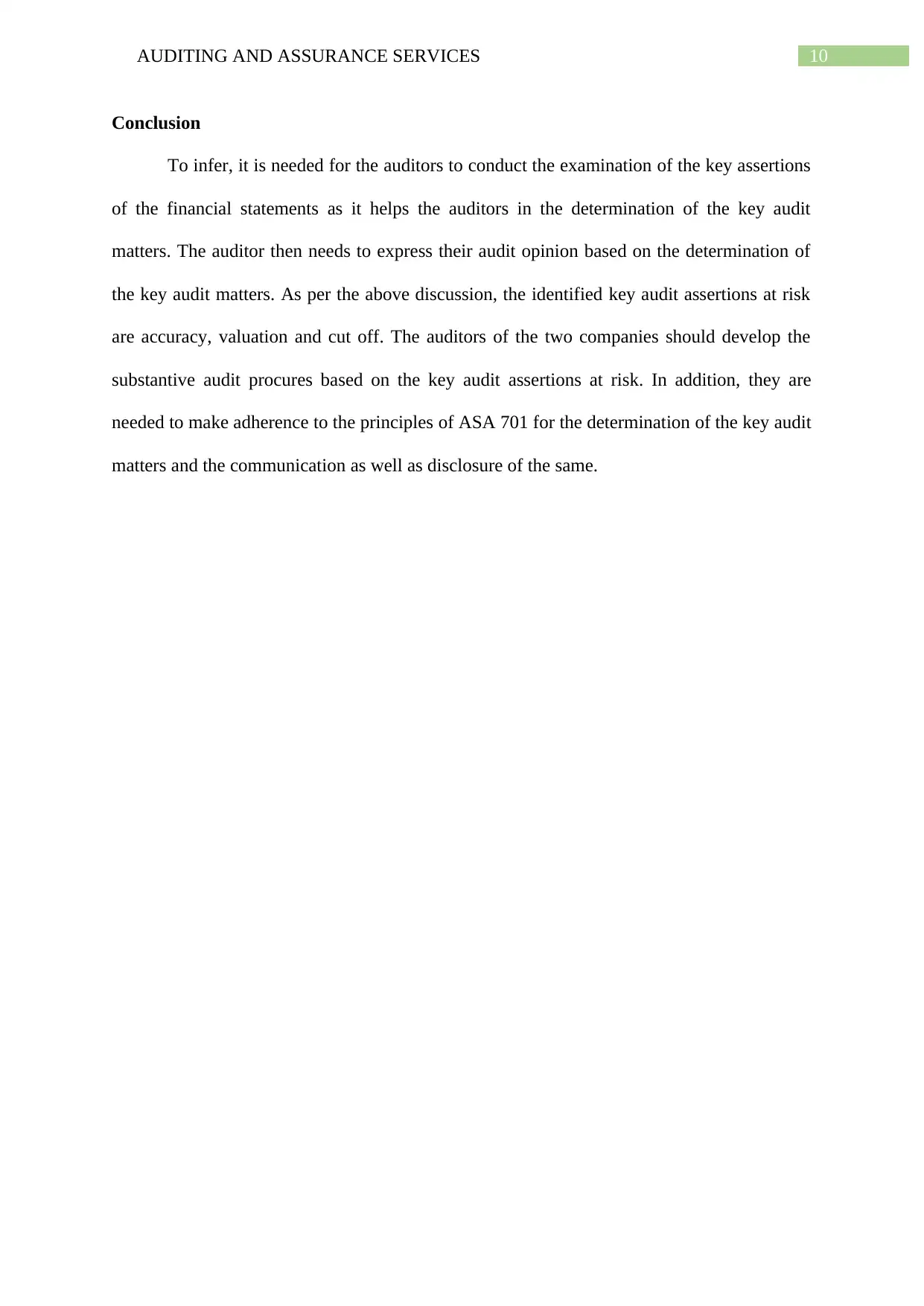
10AUDITING AND ASSURANCE SERVICES
Conclusion
To infer, it is needed for the auditors to conduct the examination of the key assertions
of the financial statements as it helps the auditors in the determination of the key audit
matters. The auditor then needs to express their audit opinion based on the determination of
the key audit matters. As per the above discussion, the identified key audit assertions at risk
are accuracy, valuation and cut off. The auditors of the two companies should develop the
substantive audit procures based on the key audit assertions at risk. In addition, they are
needed to make adherence to the principles of ASA 701 for the determination of the key audit
matters and the communication as well as disclosure of the same.
Conclusion
To infer, it is needed for the auditors to conduct the examination of the key assertions
of the financial statements as it helps the auditors in the determination of the key audit
matters. The auditor then needs to express their audit opinion based on the determination of
the key audit matters. As per the above discussion, the identified key audit assertions at risk
are accuracy, valuation and cut off. The auditors of the two companies should develop the
substantive audit procures based on the key audit assertions at risk. In addition, they are
needed to make adherence to the principles of ASA 701 for the determination of the key audit
matters and the communication as well as disclosure of the same.
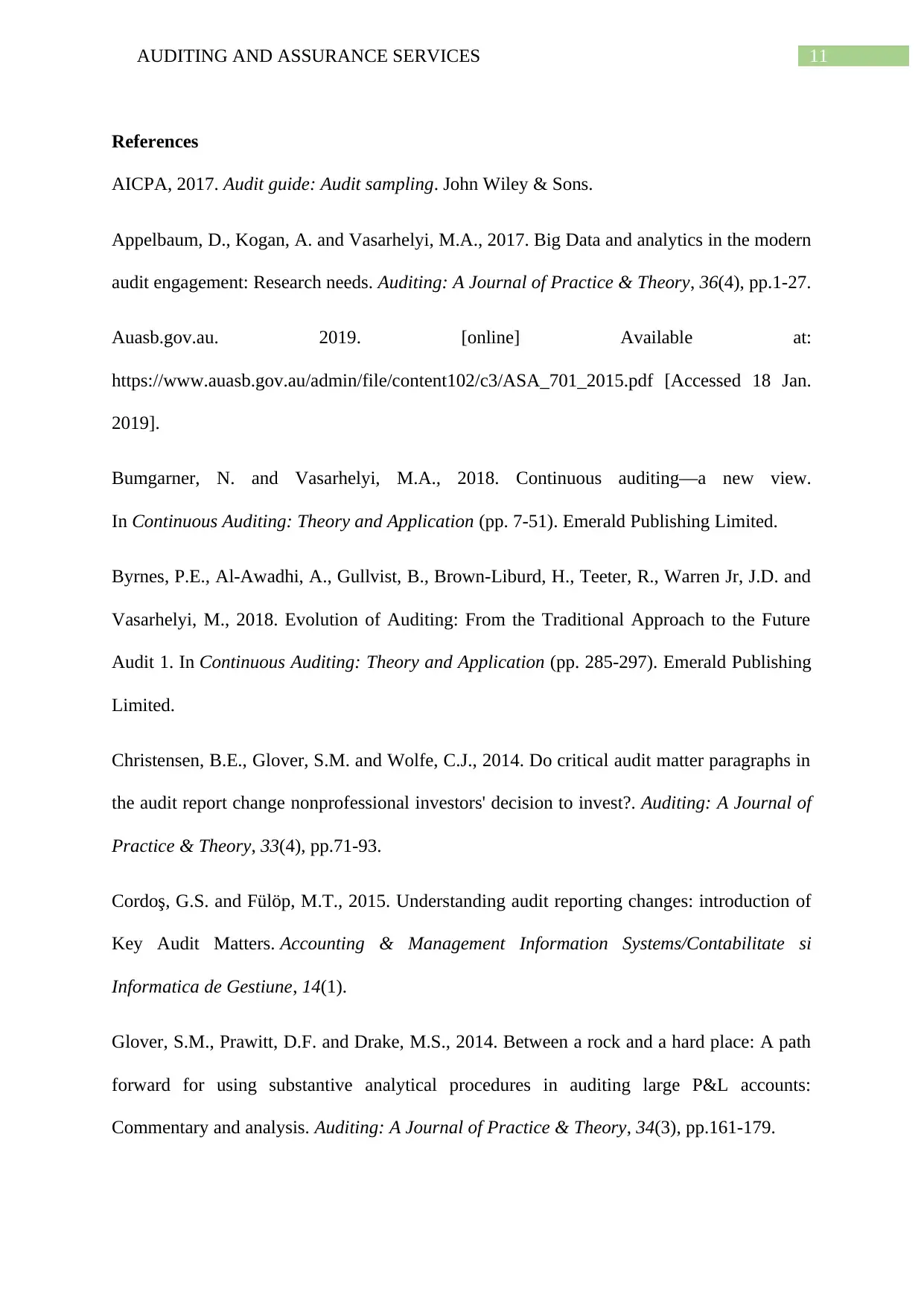
11AUDITING AND ASSURANCE SERVICES
References
AICPA, 2017. Audit guide: Audit sampling. John Wiley & Sons.
Appelbaum, D., Kogan, A. and Vasarhelyi, M.A., 2017. Big Data and analytics in the modern
audit engagement: Research needs. Auditing: A Journal of Practice & Theory, 36(4), pp.1-27.
Auasb.gov.au. 2019. [online] Available at:
https://www.auasb.gov.au/admin/file/content102/c3/ASA_701_2015.pdf [Accessed 18 Jan.
2019].
Bumgarner, N. and Vasarhelyi, M.A., 2018. Continuous auditing—a new view.
In Continuous Auditing: Theory and Application (pp. 7-51). Emerald Publishing Limited.
Byrnes, P.E., Al-Awadhi, A., Gullvist, B., Brown-Liburd, H., Teeter, R., Warren Jr, J.D. and
Vasarhelyi, M., 2018. Evolution of Auditing: From the Traditional Approach to the Future
Audit 1. In Continuous Auditing: Theory and Application (pp. 285-297). Emerald Publishing
Limited.
Christensen, B.E., Glover, S.M. and Wolfe, C.J., 2014. Do critical audit matter paragraphs in
the audit report change nonprofessional investors' decision to invest?. Auditing: A Journal of
Practice & Theory, 33(4), pp.71-93.
Cordoş, G.S. and Fülöp, M.T., 2015. Understanding audit reporting changes: introduction of
Key Audit Matters. Accounting & Management Information Systems/Contabilitate si
Informatica de Gestiune, 14(1).
Glover, S.M., Prawitt, D.F. and Drake, M.S., 2014. Between a rock and a hard place: A path
forward for using substantive analytical procedures in auditing large P&L accounts:
Commentary and analysis. Auditing: A Journal of Practice & Theory, 34(3), pp.161-179.
References
AICPA, 2017. Audit guide: Audit sampling. John Wiley & Sons.
Appelbaum, D., Kogan, A. and Vasarhelyi, M.A., 2017. Big Data and analytics in the modern
audit engagement: Research needs. Auditing: A Journal of Practice & Theory, 36(4), pp.1-27.
Auasb.gov.au. 2019. [online] Available at:
https://www.auasb.gov.au/admin/file/content102/c3/ASA_701_2015.pdf [Accessed 18 Jan.
2019].
Bumgarner, N. and Vasarhelyi, M.A., 2018. Continuous auditing—a new view.
In Continuous Auditing: Theory and Application (pp. 7-51). Emerald Publishing Limited.
Byrnes, P.E., Al-Awadhi, A., Gullvist, B., Brown-Liburd, H., Teeter, R., Warren Jr, J.D. and
Vasarhelyi, M., 2018. Evolution of Auditing: From the Traditional Approach to the Future
Audit 1. In Continuous Auditing: Theory and Application (pp. 285-297). Emerald Publishing
Limited.
Christensen, B.E., Glover, S.M. and Wolfe, C.J., 2014. Do critical audit matter paragraphs in
the audit report change nonprofessional investors' decision to invest?. Auditing: A Journal of
Practice & Theory, 33(4), pp.71-93.
Cordoş, G.S. and Fülöp, M.T., 2015. Understanding audit reporting changes: introduction of
Key Audit Matters. Accounting & Management Information Systems/Contabilitate si
Informatica de Gestiune, 14(1).
Glover, S.M., Prawitt, D.F. and Drake, M.S., 2014. Between a rock and a hard place: A path
forward for using substantive analytical procedures in auditing large P&L accounts:
Commentary and analysis. Auditing: A Journal of Practice & Theory, 34(3), pp.161-179.
⊘ This is a preview!⊘
Do you want full access?
Subscribe today to unlock all pages.

Trusted by 1+ million students worldwide
1 out of 14
Related Documents
Your All-in-One AI-Powered Toolkit for Academic Success.
+13062052269
info@desklib.com
Available 24*7 on WhatsApp / Email
![[object Object]](/_next/static/media/star-bottom.7253800d.svg)
Unlock your academic potential
Copyright © 2020–2025 A2Z Services. All Rights Reserved. Developed and managed by ZUCOL.




